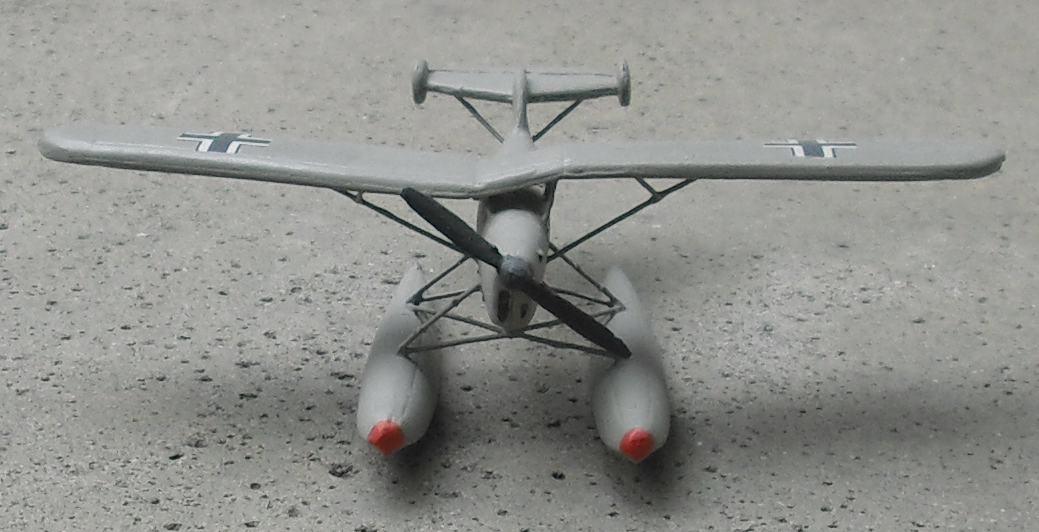Arado Ar 231 on:
[Wikipedia]
[Google]
[Amazon]
The Arado Ar 231 was a lightweight
 Designed from the outset for use on
Designed from the outset for use on 
Arado Ar 231
{{RLM aircraft designations Ar 096 1930s German military trainer aircraft Single-engined tractor aircraft Low-wing aircraft SIPA aircraft Avia aircraft Aircraft first flown in 1938 Parasol-wing aircraft 1940s German military reconnaissance aircraft Floatplanes Submarine-borne aircraft Aircraft first flown in 1941
floatplane
A floatplane is a type of seaplane with one or more slender floats mounted under the fuselage to provide buoyancy. By contrast, a flying boat uses its fuselage for buoyancy. Either type of seaplane may also have landing gear suitable for land, ...
, developed during World War II
World War II or the Second World War (1 September 1939 – 2 September 1945) was a World war, global conflict between two coalitions: the Allies of World War II, Allies and the Axis powers. World War II by country, Nearly all of the wo ...
in Nazi Germany
Nazi Germany, officially known as the German Reich and later the Greater German Reich, was the German Reich, German state between 1933 and 1945, when Adolf Hitler and the Nazi Party controlled the country, transforming it into a Totalit ...
as a scout plane
A scout is a type of United States Navy aircraft whose name derives from the scout cruisers used by the US Navy for similar roles, including screening (escorting) the fleet against enemy forces and was often combined with other roles, such as art ...
for submarine
A submarine (often shortened to sub) is a watercraft capable of independent operation underwater. (It differs from a submersible, which has more limited underwater capability.) The term "submarine" is also sometimes used historically or infor ...
s by Arado. The need to be stored inside the submarine necessitated compromises in design that made this single-seat seaplane of little practical use.
Design and development
 Designed from the outset for use on
Designed from the outset for use on U-boat
U-boats are Submarine#Military, naval submarines operated by Germany, including during the World War I, First and Second World Wars. The term is an Anglicization#Loanwords, anglicized form of the German word , a shortening of (), though the G ...
"cruiser
A cruiser is a type of warship. Modern cruisers are generally the largest ships in a fleet after aircraft carriers and amphibious assault ships, and can usually perform several operational roles from search-and-destroy to ocean escort to sea ...
s", like the Type XI B, the Ar 231 was a light parasol-wing
A monoplane is a fixed-wing aircraft configuration with a single mainplane, in contrast to a biplane or other types of multiplanes, which have multiple wings.
A monoplane has inherently the highest efficiency and lowest drag of any wing config ...
aircraft. The aircraft was powered by a 119 kW (160 hp) Hirth HM 501
The Hirth HM 501 was a 6-cylinder air-cooled inverted in-line engine that was developed by Hirth Motoren GmbH in the late 1930s, from the 4-cylinder HM 500 and used principally on the submarine-born Arado Ar 231.
Applications
* Arado Ar 231
...
inline engine, weighed around 1,000 kg (2,200 lb), and had a 10 m (33 ft) wingspan
The wingspan (or just span) of a bird or an airplane is the distance from one wingtip to the opposite wingtip. For example, the Boeing 777–200 has a wingspan of , and a wandering albatross (''Diomedea exulans'') caught in 1965 had a wingsp ...
. The design led to a simple and compact aircraft that could be fitted into a storage cylinder only 2 m (6 ft 7 in) in diameter. For ease of storage, the Ar 231's wings featured detachable sections that two operators could remove in less than six minutes. One unusual feature was an offset wing design, with the right wing root
The wing root is the part of the wing on a fixed-wing aircraft or winged-spaceship that is closest to the fuselage,Peppler, I.L.: ''From The Ground Up'', page 9. Aviation Publishers Co. Limited, Ottawa Ontario, Twenty Seventh Revised Edition, 1 ...
attaching to the wing's tilted center section (elevated above the fuselage
The fuselage (; from the French language, French ''fuselé'' "spindle-shaped") is an aircraft's main body section. It holds Aircrew, crew, passengers, or cargo. In single-engine aircraft, it will usually contain an Aircraft engine, engine as wel ...
, as on all parasol-wing designs) and lower than the left wing root, to allow the wings to overlap when folded, so as to occupy less space.

Operational history
Testing soon revealed the Ar 231s to be fragile, underpowered, and difficult to fly even during calm weather. Moreover, U-boat commanders were reluctant to linger on the surface for launch and retrieval and, as a result, development ended in favour of the Focke Achgelis Fa 330gyroglider
A rotor kite or gyrokite is an unpowered, rotary-wing aircraft. Like an autogyro or helicopter, it relies on lift created by one or more sets of rotors in order to fly. Unlike a helicopter, gyrokites and rotor kites do not have an engine power ...
. Some of the testing was done on the auxiliary cruiser ''Stier'', two of the six prototype
A prototype is an early sample, model, or release of a product built to test a concept or process. It is a term used in a variety of contexts, including semantics, design, electronics, and Software prototyping, software programming. A prototype ...
s being taken on one voyage.
Specifications (Ar 231 V1)
See also
References
* * *External links
Arado Ar 231
{{RLM aircraft designations Ar 096 1930s German military trainer aircraft Single-engined tractor aircraft Low-wing aircraft SIPA aircraft Avia aircraft Aircraft first flown in 1938 Parasol-wing aircraft 1940s German military reconnaissance aircraft Floatplanes Submarine-borne aircraft Aircraft first flown in 1941